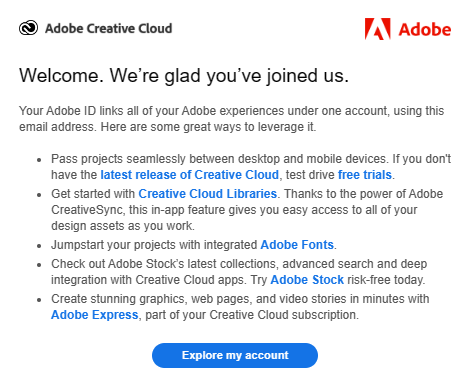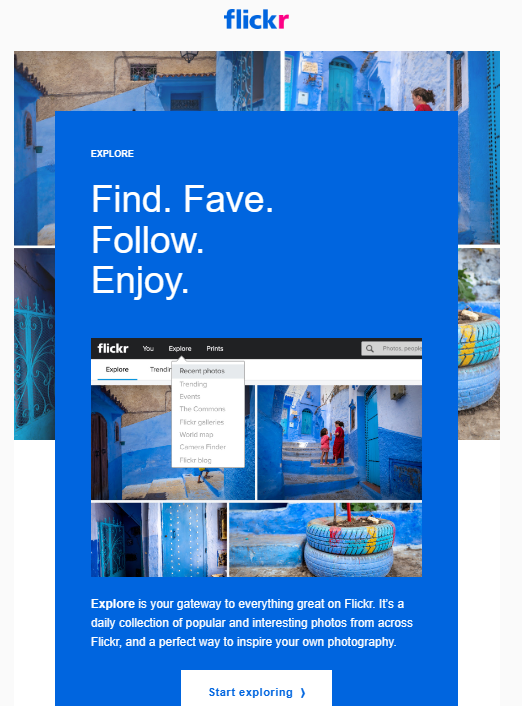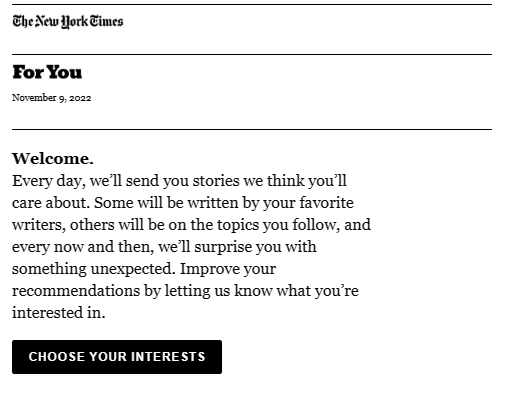Acquiring a new subscriber to your email list is always good news — but the steps you take following their signup define whether they’ll engage with your business or lose interest. One of the best things you can do to encourage further interaction is to send an onboarding welcome email.

What is an onboarding email? Onboarding emails thank new clients for subscribing and introduce them to your business. They explain what customers can expect from your future brand messages, define your company’s offers, and provide contact information if the subscriber wants to contact you. It’s the first step to establishing a continuous relationship with audience members and building retention.
Here’s what you need to know about creating an effective onboarding email strategy that maximizes results.
Designing onboarding email campaigns
An onboarding email campaign consists of a series of emails designed to welcome new subscribers and introduce them to your business. These emails are not necessarily sales-oriented (at least, not at the start) but aim to build relationships so the customer is more likely to purchase from you in the future.
Typically, an onboarding campaign starts with a welcome email — the welcome email triggers automatically when a new subscriber joins your list. It may include basic information about your brand and ask the recipient to confirm their subscription via a link.
A follow-up email for onboarding processes may include product or service recommendations, customer testimonials, or relevant brand content targeted to a subscriber’s interests.
The distinction between onboarding emails and welcome emails
Welcome emails and onboarding emails are part of an onboarding campaign strategy but have different goals. Welcome emails introduce the brand to the recipient and thank them for signing up.
An onboarding email encourages further customer interaction, such as setting email preferences, visiting the brand’s website, or scheduling an appointment. When designing your campaign, it’s important to distinguish between both types of emails.
Strategies for engaging onboarding flows
An inviting onboarding email campaign does more than introduce your business. It boosts customer engagement, increasing open rates, click-throughs, and purchases. Here are a few strategies you can incorporate into your customer onboarding strategies to enhance results.
1. Encourage app usage through targeted emails
If your brand has an app, use your welcome emails to encourage subscribers to download it. Well-designed apps are great engagement tools and allow clients to navigate your product and service offerings conveniently from their phones. Plus, if customers elect to receive app notifications, you can alert them to critical updates, like a one-day sale.
2. Build re-engagement and win-back strategies
Sometimes, your email open rates and click-through rates may decrease. That doesn’t mean you can’t turn it around. Instead, design a series of winback emails sent after client inactivity.
Re-engagement emails seek to reattract clients who appear to lose interest in your brand. They might include an exclusive discount on your products or an opportunity for a gift. There’s an incentive to entice the recipient to open the email and take action.
3. Extending trials and upselling via onboarding emails
Sometimes, customers subscribe to your mailing list after signing up for a free trial or making a purchase. If that’s the case for your brand, consider including a trial extension or recommending related products in your onboarding campaign. For instance, if a client signs up for your email list after buying a jacket from your company, you could recommend a matching hat or gloves in your onboarding email sequence.
4. Sales-touch and customer success onboarding flows
Some brands find it helpful to include customer testimonials or product demonstrations in their onboarding messages. Favorable testimonials showcase your brand in a positive light to people unfamiliar with your company. They can encourage clients currently on the fence to take action.
Content crafting for onboarding emails
The difference between an outstanding onboarding email and an average one is usually the content. Savvy marketers know to make the most of every aspect of their onboarding message, from the subject line to its design. Here are a few tips to craft a compelling onboarding email.
Write compelling subject lines and calls to action
On average, consumers receive more than 100 emails per day. That’s a lot of messages, and a portion might go unread. Don’t let your email idle in the inbox — use a captivating subject line to increase open rates. Give the recipient a reason to read your email, and they will.
However, a consumer simply opening an email won’t lead to a boost in sales. To encourage further engagement, include a clear call to action (CTA) that tells your subscribers what you want them to do.
Incorporate social proof and customer success stories
Do your subscribers need an extra nudge to take the next step with your brand? Pepper in a few examples of highly satisfied customers. For instance, you might incorporate customer feedback from a prominent review site or a pre-recorded customer success video into your email. When subscribers see how happy others are with your brand, they’re more likely to take the next step.
Utilize personalization to enhance user engagement
Subscribers aren’t very likely to interact with blast emails that don’t feel relevant. They want personalized content that feels like it’s meant just for them. Tailor your messages to make them understand that you are supporting their interests.
While mentioning their name is a good start, you can go further and include content based on prior brand interactions. For instance, if they recently purchased from you, thank them and ask for feedback about their shopping experience.
Structure emails for clarity and effectiveness
You may be wondering, “How do I write an onboard email?” When designing emails, aim for a clear, easy-to-follow format that subscribers can read on any device. Break your messaging into text blocks and incorporate eye-catching images. Make sure your CTA is prominently placed and directly links to your desired landing page.
HR departments often use onboarding emails for new hires. Have you found yourself asking, “How do I write an HR email to onboarding?” An employee onboarding email template might include:
- Basic company information
- Benefits details
- IT resources
- Structure and other important company facts
If you’re using onboarding emails in an HR setting, think about what new employees need to know about your organization and include those details.
Techniques for maximizing email onboarding efficiency
Customers can sign up for your mailing list at any time. And when they do, you might not be in front of your inbox, ready to send them an initial welcome email. That’s where investing in email marketing tools can help.
Email automation tools expedite delivery
Email automation tools are essential for any brand that incorporates onboarding campaigns into its marketing strategy. Automation tools trigger pre-drafted messages whenever a client takes a specific action, like signing up for your mailing list. The new subscriber receives your emails in a timely sequence that fits their engagement with your brand.
Constant Contact’s email marketing tools include automation features that are perfect for any email onboarding campaign. With our software, you can design and schedule emails in advance, cutting down on manual work and boosting customer engagement.
Conversion optimization using A/B testing
Changing minor elements of your marketing emails can enhance campaign results. Consider creating two or three versions of an onboarding email with different subject lines, images, or CTAs. Send them to a small portion of your subscribers, and note which one outperforms the others. This technique, known as A/B testing, can help you finesse your messages before sending them to a broader audience.
Align in-app messaging with onboarding email strategies
If your brand offers an app, consider integrating user notifications to match your onboarding strategy. For instance, you might encourage new users to set their email preferences and shopping interests. You could also offer a special discount on first purchases for subscribers who download the app. Coordinating your app messaging with your onboarding emails may boost engagement rates.
Customize onboarding flows based on user interaction
Consider personalizing your onboarding email campaign to match subscriber interactions with your brand. To start, map out a workflow for engagement activities.
For example, if a customer clicks on your CTA but doesn’t fully convert, you could send them an automatic follow-up email with an additional incentive to take action. Customizing your workflows makes your messages more relevant to the subscriber’s intent.
Advanced onboarding email tips
You can try more advanced techniques once you implement your onboarding email campaign strategy and see results.
Activation strategies for engaged and inactive users
Most marketing campaigns aim to keep subscribers interested in their emails. You can vary email marketing content based on how subscribers interact with it. For instance, a recipient who almost always opens your marketing emails might be more likely to make a purchase than someone who last read an email from you several months ago. You could send frequent readers product recommendations and work on winning inactive subscribers back to your brand.
HTML vs. plain text: choosing the right format
There are two primary email formats: plain text and HTML
- Plain text: A plain text email is just that — text only, with no images, special fonts, or colors.
- HTML: An HTML email is similar to a webpage. It can include pictures, videos, unique designs, and text variations.
While you can use either format, HTML emails make the most sense for marketing emails, especially when promoting products. Plain text is best for informational emails where the focus is on the message.
Mobile optimization for onboarding emails
Approximately 85% of consumers use smartphones to check their email. That means most subscribers may read your email on a mobile device. So, optimizing your message format to fit smartphones and regular PCs is imperative. Most email marketing tools (including Constant Contact) include mobile optimization features that help build beautiful, effective email marketing campaigns.
Converting trial users to paying customers through emails
Some brands offer free product trials and encourage users to join mailing lists during signup. If that’s the case for your company, use marketing emails to your advantage and set up a workflow to transition users to paid clients. Some techniques that might also increase conversion rates include emphasizing product value or offering a discount for a limited period.
Templates and examples of successful onboarding emails
Not sure where to start with your onboarding email campaign? Take a look at these onboarding examples from top brands to get inspired.
Adobe
Adobe’s onboarding email template includes information about its suite of creative products and a direct link to explore account options.

Flickr
Flickr’s welcome email introduces new users to features they may enjoy.

The New York Times
The New York Times provides subscribers with a personalized newsletter of content they may enjoy based on prior interactions.

Overcoming challenges in onboarding emails
You might encounter a few challenges as you implement your onboarding strategy. Here are a few to watch out for — and how to conquer them.
Disengaged users and unfinished registrations
Occasionally, consumers will subscribe to your mailing list but ignore the registration confirmation or stop opening your emails. If that happens, try to re-engage them through follow-up emails or winback campaigns.
Creating impactful post-trial surveys and discount offers
If your subscriber joined your mailing list as part of a free product trial, the goal of your onboarding emails is to convert them to paying customers. As their trial period draws to a close, ask for feedback about their experience. You might provide a special discount on paid trials for users who respond to your post-trial survey.
Developing efficient trial extension and upgrade flows
Some brands offer multiple services or products that integrate with each other. If that’s the case for your brand, encourage customers to try relevant products via a trial extension or upgrade offer. Access to additional features may result in higher paid conversion rates.
Measuring Success and Optimization
Use key performance indicators (KPIs) to measure the success of your onboarding emails, including:
- Engagement
- Open rates
- Unsubscribe rates
- Link clicks
- Other metrics
Leverage automation tools that simplify your marketing efforts and streamline the customer journey so you can focus on other important tasks that guide your audience through the sales funnel.
Resources for further learning
Developing an onboarding email campaign strategy requires creativity, planning, and know-how. If you’d like to expand your email marketing knowledge, download our free, comprehensive ebook on How to Create the Perfect Email.
You may also want to read our guide to marketing automation and personalization. Both resources can assist you as you establish a flourishing email marketing strategy.
Embrace an onboarding email strategy to bolster customer relationships
Email is a solid marketing tool that can help you connect with your audience and develop a loyal customer base. To start, introduce them to your brand and what it offers, then encourage them to provide information about their demographics and interests to help your business personalize their experience.
Onboarding emails are a great way to build genuine connections with your audience. Use our tips to create an onboarding email strategy that resonates with subscribers and delivers results.





